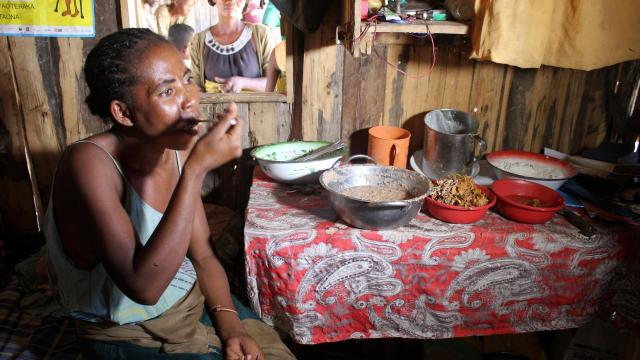Many of the climate disasters that have been front-and-centre this summer are fast-moving and devastating: fires and floods that hit quickly and leave a trail of destruction in their wake. But a slow-moving, drought-induced famine in Madagascar could preview other crises in store for our climate future.
Parts of Madagascar are currently suffering through the worst drought the country has experienced in 40 years. More than 1 million people are currently facing famine conditions and hundreds of thousands are facing potential starvation in a climate change-induced drought that experts say the residents themselves had little hand in creating.
The scenes from the particularly hard-hit regions in the south of the country, known as the Grand Sud, are horrifying. Residents are stripping spines off cactus, digging up roots, and scavenging for insects to eat, and Al Jazeera reports that aid workers have taken to calling some villages “zombie villages” — filled with just a few remaining residents who are barely surviving.
“We planted, but there was no rain,” a woman identified only as Sinazy, who lives in Mahaly with her eight children, told Al Jazeera. “Everything that’s planted dies. We don’t have anything left. Some of what we owned we sold, the rest was stolen by bandits.”
The United Nations says nearly 14,000 people are at Level 5 famine, the most serious level — classified as a “humanitarian catastrophe,” when a region has high levels of malnutrition and mortality — while nearly 400,000 people are facing Level 4 conditions. (For some context, Level 5 is when “people have absolutely nothing left to eat,” the World Food Programme’s Madagascar representative, Moumini Ouedraogo, told Al Jazeera.) Even though the drought has been dragging for years, conditions have gotten progressively more serious this summer. In the spring, just over 280,000 people were facing Level 4 conditions, and none of the population was yet in Level 5. And the trend is only going up: the World Food Programme says the number of people in Level 5 conditions could double by October if nothing is done.
These devastating conditions are linked to nearly six years of drought that has made agriculture next to impossible. Since 2015, Madagascar has consistently experienced rainy seasons where rainfall has been below average. A lot of the food insecurity in various parts of Africa is exacerbated by conflict: Sudan, Mozambique, Ethiopia, and Nigeria are all seeing famine conditions that are enhanced by wars, fighting, and struggles on top of drought and other climate impacts. But the situation in Madagascar is unique in that there are no current serious conflicts that are making the famine worse.
In a fact sheet that’s been widely reported on by multiple outlets, the World Food Programme states that Madagascar “is the only place in the world today where ‘famine-like conditions’ have been driven by climate not conflict.”
But automatically linking any famine — or drought, for that matter — to climate change deserves a little more care.
The Intergovernmental Panel on Climate Change (IPCC) report, released in early August, says that “it is likely that climate change will lead to drier conditions in Madagascar in the future, but there is little agreement on whether that is already happening,” Weston Anderson, an assistant research scientist at the University of Maryland and NASA’s Earth Sciences Division said over email. Andersen explained that linking a drought (and resulting food crisis) specifically to climate change is complex, and needs clear models that establish “whether we can attribute that drought to climate change or whether it was the result of natural variability.”
Chris Funk, the director of the Climate Hazards Centre (CHC) at the University of California, Santa Barbara, has looked at atmospheric data for southern Madagascar and says it does show temperature increases and increases in vapour pressure. “I definitely think climate change is exacerbating rainfall deficits in this area,” he said.
However, Funk also cautioned that he wasn’t able to find a lot of literature or scientific research on the links between Madagascar’s current drought and climate change. (This might explain the IPCC’s lack of clarity on the issue.) “That doesn’t mean it’s not out there,” Funk said.
“To be honest, I’m pretty uncomfortable with this theme of, like, ‘climate change caused the drought,’” Funk continued. “In general, I think climate scientists and climate attribution scientists, I’ve never heard anyone refer to anything in that sense really. It’s much more natural to talk about climate change making something worse.”
And on that last point, the data’s pretty clear. The annual average temperature in Madagascar is expected to increase between 2.5 degrees Celsius and 3.5 degrees Celsius by the end of the century. Climate change, the IPCC report has found, will juice up heat waves and droughts; the types of extreme droughts we used to see once per decade could happen two to three times more often if warming gets to 2 degrees Celsius. That means that catastrophes like the ones we’re seeing in Madagascar could become even more all-too-common in different areas of the world as climate change makes conditions riper for drought.
“There is clear evidence that climate change is exacerbating droughts in dry areas — we’re seeing it all across the western U.S. right now,” Funk said.
